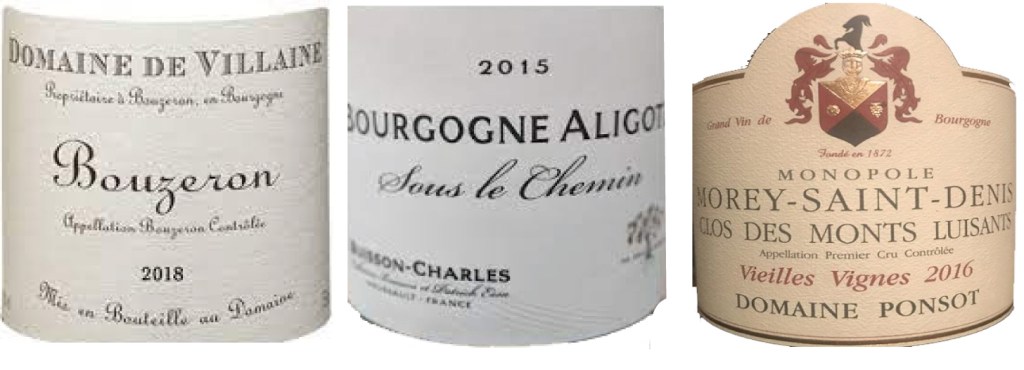Aligoté is not quite the grape variety that dare not speak its name, but it is certainly quite subservient to Chardonnay in Burgundy. It is found only in a relatively small production of Bourgogne Aligoté and in Bouzeron on the Côte Chalonnaise where it is the authorized white grape variety. The problem with Aligoté has always been its piercing acidity, but could that now become an advantage in the era of global warming, when Chardonnay can lose acidity and become over-ripe and overblown?
“Of course, thanks to global warming it is more and more important. Because Chardonnay is less and less vibrant. The skin of Chardonnay is becoming thicker and this brings bitterness, which may replace acidity,” says Pierre de Benoist at Domaine de Villaine, the top domain in Bouzeron. (Pierre is the nephew of Aubert de Villaine, of Domaine de la Romanée Conti, who established the domain in Bouzeron in 1971.)
Part of the problem with Aligoté is that the dominant cultivar—from which the available clones are derived—is Aligoté Vert. Domaine de Villaine grows the Aligoté Doré subvariety, which achieves greater ripeness. It’s been propagated by selection massale from some very old plants, some 115 years old representing the first planting after phylloxera.
Burgundy’s top Aligoté vineyard is Domaine Ponsot’s premier cru Monts Luisants in Morey St. Denis, one of the rare plantings of a white variety on the Côte de Nuits. (It is curious that although white plantings dominate the southern part of the Côte de Beaune and are rare on the Côte de Nuits, it is the latter that has all the variety ,with the Gouges strain of Pinot Blanc growing in premier crus in Nuits St. Georges, as well as the Aligoté in Morey St. Denis.)
The Luisants vineyard consists of 80% old vines planted in 1911 and 20% replanted in 2006. It cannot have been easy to maintain, because for a while planting Aligoté was not allowed in premier crus, although the restriction now has been lifted. Actually, Aligoté may be more common than is always realized: some years ago a producer on the Côte de Nuits said to me darkly, “you would be amazed how much Aligoté there is in Corton Charlemagne if you take a look at the vines.” Indeed, as Alexandre Abel at Domaine Ponsot points out, “The reputation of Corton Charlemagne was established in the 19th century when there was a huge proportion of Aligoté.”
Monts Luisants has become more consistent and precise since Alexandre took over winemaking in 2017. It used to be fermented in stainless steel and moved to barrique only after fermentation. Now it is moved to barrique around halfway through fermentation. “In 2017 we started to press it more gently and we don’t use sulfur,” Alexandre says.
One of the most interesting Aligoté cuvées I tasted comes from Meursault (of course, the vines may be in Meursault but the wine is Bourgogne Aligoté). Patrick Essa of Domaine Buisson-Charles is a person of strong opinions. When I had to change the time of our appointment because another producer had a problem with timing as he had to pick up his wife and children at the railway station, Patrick said, “Keep in mind that a vigneron whose principal concern is to collect his wife from the train is not as passionate as he should be about what he does.”
Patrick harvests the Bourgogne Aligoté as late as possible. “Aligoté goes from green to doré to rosé and I like it to be rosé.” Will Aligoté become more prominent because of global warming causing loss of acidity in Chardonnay. “I don’t have any problem with Chardonnay, lack of acidity is a problem caused by high yields.”
Global warming is forcing producers to reconsider what grape varieties may be appropriate everywhere wine is made. In the Rhône, they are bringing back varieties such as Counoise and Cinsault, that had been more or less phased out, because they produce less alcohol than Grenache. With Burgundy whites, the problem is more lack of acidity than gain in alcohol, but the question is the same: could a different variety produce better results if global warming continues?

Tastings
Domaine De Villaine, Bouzeron, 2021
This is a blend from 17 plots of Aligoté in Bouzeron. They come from 9 lieu-dits and each lieu-dit is vinified separately in a foudre. Average age is 65 years and the oldest vines are 115 years. This vintage shows good acidity, but not oppressive, with inclinations towards salinity. Quite savory and fresh. Considering this is a cooler year, shows very good roundness. 89 Drink –2027
Domaine Ponsot, Monts Luisants, 2020
The acidity is really very well controlled and is more in the background than upfront. Fruits are quite lemony but the palate is silky, round, viscous, but without the fullness of Chardonnay. This is a leaner style, pointing in a more saline direction. 90 Drink –2030
Domaine Buisson-Charles, Bourgogne Aligoté, 2022
(barrel sample) Almost stern impression to nose. Round, ripe, and flavorful, mingling fruity and savory impressions. A good example of the potential complexity of Aligoté. 88 Drink -2027

Pingback: A little light reading… ICYMI – Burgundy-Report